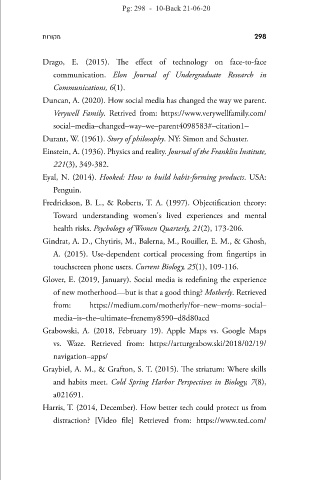Page 298 - ETUZUV HATODAA.ETUZUV HATODAA.1A
P. 298
Pg: 298 - 10-Back 21-06-20
מקורות 298
Drago, E. (2015). The effect of technology on face-to-face
communication. Elon Journal of Undergraduate Research in
Communications, 6(1).
Duncan, A. (2020). How social media has changed the way we parent.
Verywell Family. Retrived from: https://www.verywellfamily.com/
social־media־changed־way־we־parent4098583#־citation1־
Durant, W. (1961). Story of philosophy. NY: Simon and Schuster.
Einstein, A. (1936). Physics and reality. Journal of the Franklin Institute,
221(3), 349-382.
Eyal, N. (2014). Hooked: How to build habit-forming products. USA:
Penguin.
Fredrickson, B. L., & Roberts, T. A. (1997). Objectification theory:
Toward understanding women׳s lived experiences and mental
health risks. Psychology of Women Quarterly, 21(2), 173-206.
Gindrat, A. D., Chytiris, M., Balerna, M., Rouiller, E. M., & Ghosh,
A. (2015). Use-dependent cortical processing from fingertips in
touchscreen phone users. Current Biology, 25(1), 109-116.
Glover, E. (2019, January). Social media is redefining the experience
of new motherhood—but is that a good thing? Motherly. Retrieved
from: https://medium.com/motherly/for־new־moms־social־
media־is־the־ultimate־frenemy8590־d8d80acd
Grabowski, A. (2018, February 19). Apple Maps vs. Google Maps
vs. Waze. Retrieved from: https://arturgrabow.ski/2018/02/19/
navigation־apps/
Graybiel, A. M., & Grafton, S. T. (2015). The striatum: Where skills
and habits meet. Cold Spring Harbor Perspectives in Biology, 7(8),
a021691.
Harris, T. (2014, December). How better tech could protect us from
distraction? [Video file] Retrieved from: https://www.ted.com/

